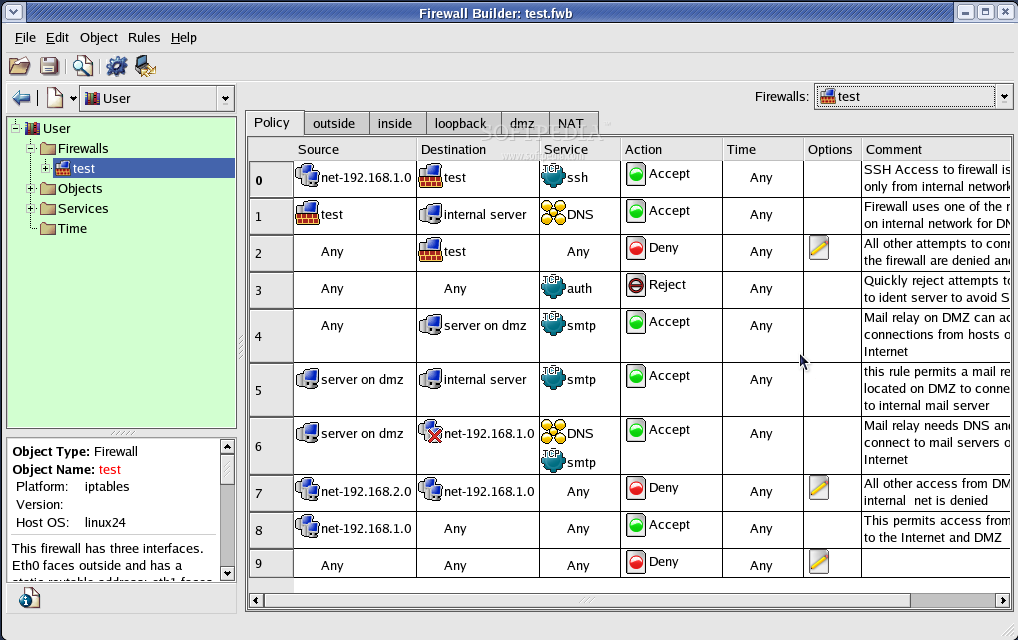
- Firewall builder policy read from bottom up pdf#
- Firewall builder policy read from bottom up manual#
In other words, your readers are likely going to try to navigate your material in a bottom-up fashion, and the attempt may well be disappointing. Relying on a TOC alone is not going to help much, because the TOC will probably be too big to be useful, and people are not particularly likely to use it, since Google has trained them to search. What all this means is that if people do log in to your site to use your documentation, they are probably going to start by searching, and their search has a good chance of not working very well. Even if they have the technology to search like Google, they don’t have the data. The search in your help system has still less. Your site search as little or none of that. It is about identifying the preferred resource for a given query, and a Web search engine like Google has millions of data points about the queries people make and the resources they choose to draw on to make good recommendations. The problem is, searching a site does not work nearly as well as searching the Web. People turn to search because the information space is too large and complex to navigate top down, and because Google has taught them that searching works. If you have only a few products, people may be able to do that by choosing from a list, but if the list gets long or complex, people are more likely to turn to site search. But when people look for information on our web site, they have to narrow the search field for themselves. When books were delivered in the box with a product, we narrowed the search field down for people by putting the right book in the right box. At the same time, it is not workable in an online environment to offer many individual books or help systems. Most significant documentation sets are substantially bigger than a single TOC and handle effectively. Until we can convince management that it needs to be on the Web, we have to create content that works in isolation.Ĭontent does not have to reach the scale of the Web to become too large for a single TOC.
Firewall builder policy read from bottom up manual#
People are more likely to go to Google first and the manual second or never.Įxcept in the most extreme circumstances (missile silos, nuclear power plants, Fort Knox) we need to get our content on the Web if we want it to remain relevant.įor various reasons, though, many organizations still exist in keeping their technical content behind a login. But this assumes that the first place the reader looks is in the manual, and that they go to Google only if the manual fails them. I hear some writers say that they want to avoid sending the reader off to Google. If they don’t find one, many will conclude there isn’t one. For an increasing number of people, the first thing they do when they have a technical question is Google for an answer. The first problem is that if it is not on the Web, people may not try to navigate it at all. But it will show up where it is relevant.īut it is a different story when it is not on the Web. Few searches will turn up our small booklet because it is not relevant to most of them. Search works there because it searches everything. Put those small pieces of content on the Web and people will find them with Google. Make it just a little bit bigger, and a TOC becomes practical, while search remains problematic. Such a document can only be navigated by scanning or simply reading through. Unless you already knew exactly what was in it, almost no query would deliver any hits. It does not offer enough entry points, and any attempt to search it would be futile. Yahoo’s top-down directory of the Web, created when the Web was still relatively small, was recently shuttered, after having been irrelevant for many years.Īt the other end of the scale, a booklet of a few pages cannot really be navigated bottom-up. The Web is far far to big and too complex to ever be navigated top down. Q: What happens when the information is behind a wall, such as proprietary applications? How is a bottom-up approach better in that type of scenario?Ī: The Web is the ultimate bottom-up information architecture. This is the second of the questions from my TC Dojo presentation on Information Architecture Bottom Up.


Firewall builder policy read from bottom up pdf#
PDF in a Bottom-up Information Architecture.Search ranking and bottom-up architecture.Learning in a Bottom-up Information Architecture The role of the TOC in a bottom-up information architecture.Bottom-Up Architecture Q and A: Organizing the Site.Bottom-Up Information Architecture Behind the Firewall.Bottom-Up Information Architecture Q and A – Part 1.Bottom-Up Information Architecture Q and A


 0 kommentar(er)
0 kommentar(er)
